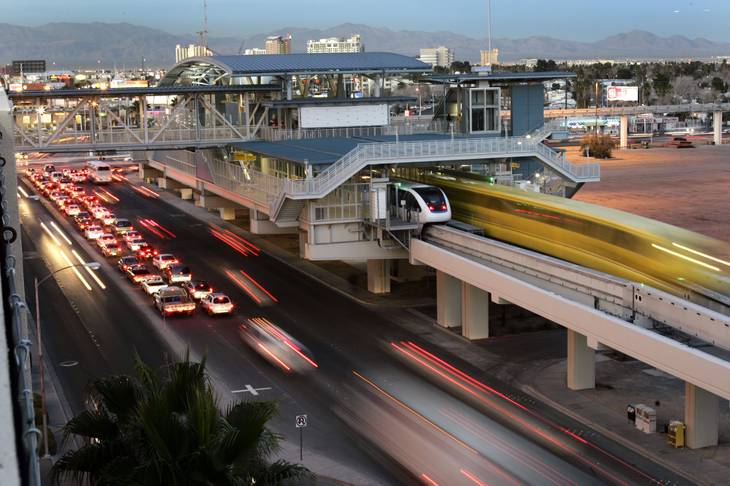Investors in bonds of the bankrupt Las Vegas Monorail charge in a new lawsuit that they weren’t told about a prophetic study commissioned for the Venetian resort in 2000 finding the Monorail’s financial projections to be overly optimistic.
The charge was made in a Sept. 23 federal lawsuit filed by Lord Abbett Municipal Income Fund Inc. against Citigroup Global Markets, which had marketed some of the bonds to investors.
The monorail company filed for bankruptcy in January 2010 as analysts warned it will never generate enough revenue to service its $649 million in state-issued bond debt. Although the bonds were issued by the state, they weren’t guaranteed by the state.
Efforts by the monorail to shed most of its debt and emerge from bankruptcy have been delayed by disputes with creditors, with the latest reorganization plan on the table to be aired during a Nov. 14 hearing.
Lord Abbett’s lawsuit laid out this sequence of events:
In 2000 the state issued three tiers of Monorail bonds to finance the design, construction and operation of the monorail over a 3.9-mile route behind casinos on the east side of the Las Vegas Strip and then extending to Paradise Road, the Las Vegas Convention Center and the Sahara hotel. In all, it would have 36 cars serving seven stations.
Las Vegas Sands Corp.’s Venetian resort, which opposed the Monorail, engaged Wendell Cox Consultancy, an Illinois firm, to analyze the Monorail revenue projections and the Cox report was provided to Citigroup before the bonds were issued in September 2000.
Cox concluded "that the ridership and advertising projections supporting the Monorail project were among the most aggressive in U.S. transit history and could emerge as the least accurate," the lawsuit says.
The Las Vegas Monorail Co., in the meantime, paid for and provided to Citigroup a study by URS Greiner Woodward Clyde Inc. This report projected that in 2004, the Monorail’s first year of expected operation, annual ridership would be about 35 million people and advertising revenue would be about $8.1 million, "generating sufficient cash flow to pay debt service on the Monorail bonds."
Cox, however, projected maximum annual ridership of about 9.2 million people and advertising revenue of about $3.3 million.
URS projected ridership would increase every year, including years with fare increases, while Cox predicted ridership would drop in response to even modest increases in fares.
"Cox predicted the Monorail could not generate sufficient revenue to make any meaningful amount of principal and interest payments on the Monorail bonds," the lawsuit says. "The report noted that the Monorail was 'projected to carry more passengers per route mile than the New York subway, the London Underground and the Stockholm Metro, and more than double that of the most heavily-used new rail systems in the United States."’
Lord Abbett, a fund based in New Jersey, in 2006 bought $13 million of the second tier bonds offered and sold by Citigroup that were secured principally by Monorail revenue. These were among the bonds that had been issued by the state in 2000.
"The conclusions in the Cox report proved to be prophetic. In 2005, the first full year of operation, the Monorail did not achieve anywhere near the level of ridership that had been projected in the URS study," the lawsuit says. "Monorail ridership was about 10 percent greater than the optimistic projection in the Cox report, but was about half the ridership projection in the URS study. Advertising revenue was substantially less than the conservative estimate in the Cox report."
The lawsuit charges Citigroup was aware of the Cox report since 2000 and the financial performance of the Monorail by mid-2006, but failed to disclose the Cox report to Lord Abbett as Citigroup was trying to establish a high secondary market trading price for the second tier bonds.
This was at a time that the Monorail was considering expanding to McCarran International Airport and to the west side of the Las Vegas Strip – an expansion that would require the issuance of more than $1 billion of new bonds.
"Citigroup wanted to be retained as an underwriter for any such bond issue," the lawsuit charges.
"Had Lord Abbett been told about the Cox report or the factual basis for the conclusions in the Cox report, it would not have purchased the bonds," charged the lawsuit, which said Lord Abbett’s bankruptcy recovery from the Monorail bonds "is likely to be minimal."
"The second tier bonds are now virtually worthless," the suit says, asserting counts of fraud, negligent misrepresentation and violation of the New Jersey Securities Act.
The suit seeks unspecified damages including punitive damages.
Citigroup told the Wall Street Journal, which earlier reported on the lawsuit, that the suit "is without merit."
Las Vegas Sun archives from 2000 show the Wendell Cox Consultancy’s pessimism about the Monorail was regularly reported and that at times its work was presented by Monorail foes and skeptics including the taxi industry and the Mandalay Bay resort.
At the time, Mandalay Bay was a competitor with the MGM Grand, where the Monorail originates. Now, MGM Grand and Mandalay Bay are part of the same company: MGM Resorts International.
Besides the Cox report, records in the bankruptcy case show that as early as August 2005 the Monorail board had been warned the system could not cover its bond debt because of disappointing ridership and revenue levels.
Besides its startup problems, the recession deepened problems for the Monorail.
Ridership fell to 5.2 million people in 2010 from 7.9 million people in 2007.
